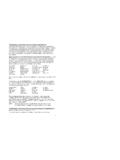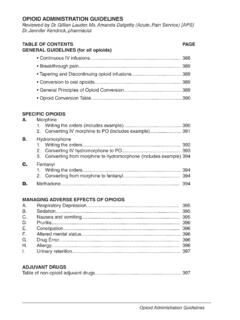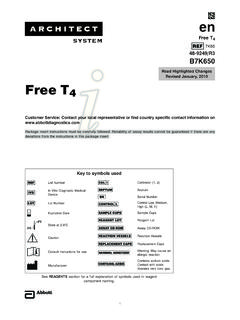Transcription of PROTOCOLS FOR ANTICOAGULANT AND …
1 PROTOCOLS FOR ANTICOAGULANT AND thrombolytic THERAPYW ritten by Drs. Evan Shereck and John Wu, Division of Hematology/Oncology/BMT and Alison MacDonald, pharmacistReferences: Antithrombotic therapy . In: The 2009 Formulary of the Hospital for Sick Children, 11th edition. Toronto 2008. Monagle P et al (eds). Andrew s Pediatric Thromboembolism and Stroke 3rd ed. 2006; BC Decker Inc. Hamilton. Monagle P et al. Antithrombotic therapy in neonates and children: ACCP evidence-based clinical practice guidelines (8th edition). Chest 2008; 133: 887S-968S Malowwany JI, Monagle P, Wu J et al.
2 Enoxaparin for neonatal thrombosis: A call for a higher dose for neonates. Thrombosis Research 2008; 122: : protocol for heparin for warfarin for enoxaparin for systemic thrombolytic Information Sheet ..pageWarfarin Information Information sheet for thrombolytic for ANTICOAGULANT and thrombolytic therapy 1 protocol FOR HEPARIN therapy (for patients > 1 month of age) Always obtain baseline PT/INR, APTT, CBC and fibrinogen before starting therapy Once APTT is in the therapeutic range, repeat APTT daily; CBC and platelets are to be checked twice weeklyLOADING DOSE: 75 units/kg (maximum: 5000 units/dose)-infuse IV over 10 minutes by syringe pumpINITIAL MAINTENANCE DOSE:< 1 year of age:28 units/kg/hr> 1 year of age:20 units/kg/hrAdolescents and adults18 units/kg/hr (maximum 1000 units/hr)Obtain APTT 4 hours after loading dose and adjust dose according to (sec.)
3 Bolus (units/kg)Holdtime (min.)Rate ChangeRepeat APTT< 40500 20%4 hr40 4900 10%4 hr50 750004 hr then next day76 8500 10%4 hr86 95030 10%4 hr> 95060 15%4 hrUSUAL CONCENTRATION FOR MAINTENANCE HEPARIN:-50 units/mL for majority of patients-100 units/mL for patients who are severely fluid restricted-Use D5W (but also compatible with saline)CORRECT WRITING OF ORDERS:Write orders as: Heparin infusion (50 units/mL) in D5W; infuse IV at ____mL/hr (____ Units/kg/hr) The use of the ANTICOAGULANT monitoring sheet during therapy is strongly for ANTICOAGULANT and thrombolytic therapy 2 protocol FOR WARFARIN therapy Always obtain baseline PT/INR, APTT, CBC and fibrinogen before starting treatment.
4 Maximum initial loading dose mg/kg. Reduce this to mg/kg in patients post-Fontan surgery, liver dysfunction or severe renal impairment. Usual maintenance dose is about mg/kg/day Once daily dosing; to be given at 1800 hrs. Round dose to nearest mg. The rate of INR change influences dosing changes: if INR increases quickly be conservative with subsequent dose DOSE:DayINRDose of warfarinLoading dose Day mg/kgDay mg/kg (50% of initial loading dose)2 mg/kg (50% of initial loading dose) mg/kg (25% of initial loading dose)> dose until INR <.
5 Then restart at 50% less than previous doseLONG-TERM MAINTENANCE DOSAGE GUIDELINES: DayINRDose of warfarinDay 5 and beyond (dose dependent on INR) - dose by 20% - dose by 10%2 - 3no - dose by 10%> until INR < , restart at 20% less than previous dosePROTOCOL FOR ENOXAPARIN Enoxaparin is the only low molecular weight heparin (LMWH) on formulary at C & WProtocols for ANTICOAGULANT and thrombolytic therapy 3 Hematology consult is suggested prior to use Obtain baseline coagulation screen, CBC and renal *Ensure that whole milligrams are ordered to facilitate administration with an insulin syringe, 6 milligrams instead of milligrams*Use with caution and dose may need to be adjusted in renal < 2 monthsAge > 2 monthsEnoxaparin treatment mg/kg/dose SC Q12H1 mg/kg/dose SC Q12 HMonitoring Therapeutic range of anti Xa.
6 1 unit/mL Anti Xa levels should be drawn 4 hours after the second dose, or the second new dose, if changed. 30 unit insulin syringes can be used to measure small doses; In insulin syringes 1 mg = 1 unit Prior to invasive procedures such as lumbar punctures, omit 2 previous doses of enoxaparinanti-Xa level at 4 hours (units/mL)Dose change< Increase by 25% - by 10% - - by 20% - by 30%> by 40% protocol FOR SYSTEMIC thrombolytic therapy * Hematology consult required* PROTOCOLS for ANTICOAGULANT and thrombolytic therapy 4 Alteplase (tissue plasminogen activator, tPA) No loading dose Infuse IV at mg/kg/hr x 6 hours.
7 Do not continue infusion beyond 6 hours. Consider heparin at 10 units/kg/hr during alteplase infusion (do not give a heparin loading dose). Start as soon as possible, aiming for several hours of heparin prior to starting alteplase. If patient is already on therapeutic heparin, reduce the infusion rate to 10 units/kg/hr 30 minutes prior to starting alteplase. (Judicious use of IV heparin infusion is indicated to prevent thrombin generation.) Re-evaluate with objective testing (radiographically or return of pulses and BP for arterial thrombi) following 6 hours of infusion.
8 30 60 minutes after alteplase infusion is finished, start titrating heparin infusion up toward therapeutic APTT without bolus doses If no response, measure the plasminogen level. If low, administer FFP at 20 mL/kg every 8 hours. A repeat alteplase infusion can be considered 12-24 hours after completing initial Aim to decrease fibrinogen by 20-50% with increase D dimers to achieve a systemic thrombolytic state. At 4-6 hours : CBC (platelets), PT, APTT, fibrinogen, D dimer (to ensure lytic state achieved) then measure fibrinogen every 6 hours if possible Consider measuring plasminogen level at the end of the 6 hour infusion if no response, or prior to another course (keep in mind that added venous punctures increase the risk of bleeding).
9 Maintain fibrinogen levels > 100 mg/dL; give cryoprecipitate (1 unit/5 kg) for severe hypofibrinoginemia. Give FFP 20 mL/kg Q6-8H if plasminogen is low. Maintain platelet count > 100,000 Daily: PT, APTT, fibrinogen, D dimmer, CBCIf severe bleeding: Stop alteplase infusion, give cryoprecipitate (usual dose 1 bag/5 kg body weight or 5-10 mL/kg) and give IV tranexamic acid 10 mg/kg/doseProtocols for ANTICOAGULANT and thrombolytic therapy 5 HEPARIN INFORMATION SHEET Requires a dedicated line for IV infusion. A separate peripheral line will be required for drawing of APTT levels and administration of incompatible medications.
10 Blood for APTT shoud NOT be drawn on the extremity where heparin drip is infusing. Avoid IM injections, arterial punctures and, where possible, antiplatelet agents such as ASA, NSAIDs (eg ketorolac). Stop heparin 4 hours prior to invasive procedures such as LP or pacer wire removal. Platelet count should be maintained above 60,000 during therapy . If there is an abrupt decrease in the platelet count ( 50% decrease) suspect heparin-induced thrombocytopenia (HIT). If transitioning to oral anticoagulation, start on day 1 of heparin and overlap for 5 days.



